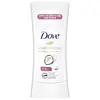What's inside
What's inside
 Key Ingredients
Key Ingredients

 Benefits
Benefits

 Concerns
Concerns

 Ingredients Side-by-side
Ingredients Side-by-side

Aluminum Sesquichlorohydrate
AstringentPPG-15 Stearyl Ether
EmollientOzokerite
Emulsion StabilisingNeopentyl Glycol Diheptanoate
EmollientStearyl Alcohol
EmollientIsododecane
EmollientIsopentyldiol
HumectantLauryl Laurate
Skin ConditioningMandelic Acid
AntimicrobialSorbitan Oleate
EmulsifyingMaranta Arundinacea Root Powder
Skin ConditioningSilica
AbrasiveCitronellyl Methylcrotonate
MaskingZea Mays Starch
AbsorbentEthylhexylglycerin
Skin ConditioningPanthenol
Skin ConditioningCaffeine
Skin ConditioningParfum
MaskingAluminum Sesquichlorohydrate, PPG-15 Stearyl Ether, Ozokerite, Neopentyl Glycol Diheptanoate, Stearyl Alcohol, Isododecane, Isopentyldiol, Lauryl Laurate, Mandelic Acid, Sorbitan Oleate, Maranta Arundinacea Root Powder, Silica, Citronellyl Methylcrotonate, Zea Mays Starch, Ethylhexylglycerin, Panthenol, Caffeine, Parfum
Ingredients Explained
These ingredients are found in both products.
Ingredients higher up in an ingredient list are typically present in a larger amount.
Parfum is a catch-all term for an ingredient or more that is used to give a scent to products.
Also called "fragrance", this ingredient can be a blend of hundreds of chemicals or plant oils. This means every product with "fragrance" or "parfum" in the ingredients list is a different mixture.
For instance, Habanolide is a proprietary trade name for a specific aroma chemical. When used as a fragrance ingredient in cosmetics, most aroma chemicals fall under the broad labeling category of “FRAGRANCE” or “PARFUM” according to EU and US regulations.
The term 'parfum' or 'fragrance' is not regulated in many countries. In many cases, it is up to the brand to define this term.
For instance, many brands choose to label themselves as "fragrance-free" because they are not using synthetic fragrances. However, their products may still contain ingredients such as essential oils that are considered a fragrance by INCI standards.
One example is Calendula flower extract. Calendula is an essential oil that still imparts a scent or 'fragrance'.
Depending on the blend, the ingredients in the mixture can cause allergies and sensitivities on the skin. Some ingredients that are known EU allergens include linalool and citronellol.
Parfum can also be used to mask or cover an unpleasant scent.
The bottom line is: not all fragrances/parfum/ingredients are created equally. If you are worried about fragrances, we recommend taking a closer look at an ingredient. And of course, we always recommend speaking with a professional.
Learn more about ParfumSilica, also known as silicon dioxide, is a naturally occurring mineral. It is used as a fine, spherical, and porous powder in cosmetics.
Though it has exfoliant properties, the function of silica varies depending on the product.
The unique structure of silica enhances the spreadability and adds smoothness, making it a great texture enhancer.
It is also used as an active carrier, emulsifier, and mattifier due to its ability to absorb excess oil.
In some products, tiny microneedles called spicules are made from silica or hydrolyzed sponge. When you rub them in, they lightly polish away dead skin layers and enhance the penetration of active ingredients.
Learn more about SilicaStearyl Alcohol is a type of fatty alcohol from stearic acid. It is a white, waxy compound used to emulsify ingredients.
Fatty Alcohols are most often used as an emollient or to thicken a product. Emollients help soothe and hydrate the skin by trapping moisture.
They are usually derived from natural fats and oils and therefore do not have the same drying or irritating effect as solvent alcohols. FDA allows products labeled "alcohol-free" to have fatty alcohols.
Learn more about Stearyl Alcohol